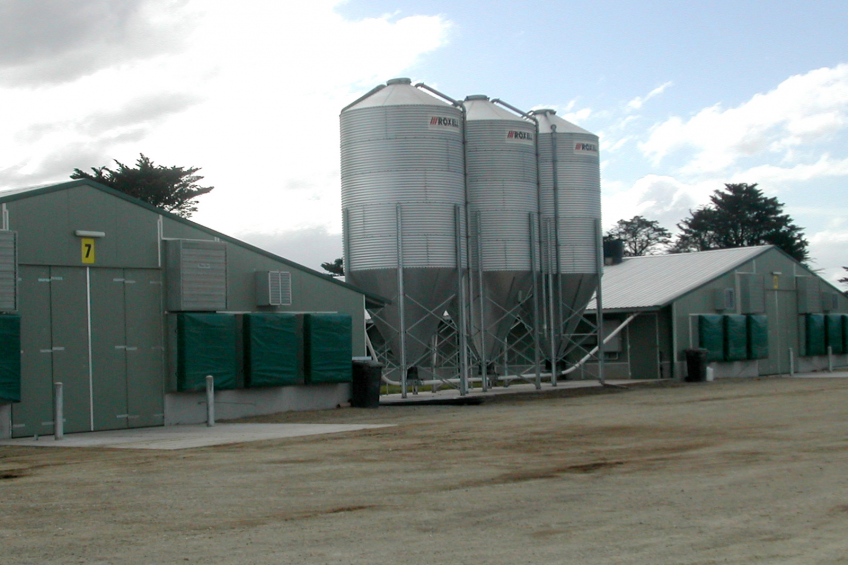7 tips for correct poultry feed storage

Proper feed storage is essential, the use of poor storage facilities will lead to deterioration of feed quality. This, in turn, will result in poor growth, malnutrition, health problems and possibly high mortality of the animals. All of which decrease farm profitability. Here are 7 tips to keep in mind.
Distance from poultry house
For practical reasons, the distance between the storage facility and a poultry house should be kept to a minimum. Although you may find such facilities inside animal houses, most poultry farms make use of silos which are placed next to the house in which the birds are kept and fed.
The storage facility
When thinking of feed storage, one could picture a fairly simple facility in which feed can be kept until it is needed. Feed needs to be protected therefore a feed storage facility should meet a number of criteria to be considered good enough:
– Provide a shelter from direct sunlight and rain.
– Be properly ventilated and cool.
– Keep feed dry (and therefore ensure low humidity).
– Protect feed from vermin (rats/mice) and insect pests.
– Keep the feed off the ground to prevent ground condensation and mould spoilage.
– Keep feed away from chemicals and drugs
Storage conditions
Poor storage will reduce the shelf-life of the feed through loss of critical nutrients, such as vitamins, essential fatty acids and anti-oxidants. This will lead to reduced growth and higher mortalities due to poor bird health.
Feed subjected to wet storage conditions may become stale and mouldy. These moulds may grow quickly and produce mycotoxins, which is particularly the case during warm weather. The use of mouldy feeds may lead to performance losses, illnesses, and mass mortalities.
It is difficult to say how long feed can remain in a storage facility. It depends largely on how the feed is composed and the conditions within the storage facility. In this respect, climate will play an important role. The temperature and the relative humidity of the air can also have a tremendous influence on the condition of the feed.
Even with a good feed storage system, feed should only be stored for a short period of time, ideally for less than two months from the date of the feed being manufactured. Cutting down storage time ensures that the feed is turned over faster, thereby reducing the inventory costs and providing the birds with fresh, high quality feed.
Temperature
When storing feed in bins placed outside, one should realise that radiation from the sun during the day creates a greenhouse effect inside the bin. Overheating can have a major impact on the nutritional value of the feed stored, in which case proteins may be broken down or fat may become rancid, for example.
Heat from the sun can easily penetrate as far as 20 cm deep in the feed mass inside a bin! In this case, metal bins with corrugated sheet shave the advantage of reflecting a large amount of that radiation heat. This is one of the reasons why these types of bins are preferred in hot climatic regions.
In deserts it is often advised to make use of insulated bins to keep the feed temperature as steady as possible. These bins have an exterior bin placed over the feed bin with thick insulation material in between the two surfaces. Insulated bins also prevent condensation when the temperature drops at night. Condensation not only increases the risk of mould forming on the top layer of the feed and along the inside of the bin walls, but it may also cause bridging of the feed since it may stick on the bin wall.
Calculating the number of bins needed
Once the right type of storage facility has been chosen, the question is what the total storage capacity should be. The answer largely depends on the delivery time from the feed supplier, but a simple equation is: number of birds x maximum intake/bird/day x delivery time in days . Once the total capacity needed is known, the number of bins on the farm can be determined. There is, however, one more issue that should be kept in mind before determining the number of bins per poultry house, and that is: how many different types of feed will be used?
- In general, broilers require only one type of feed. In case of phase-feeding or when feed is mixed with other ingredients, such as corn, then a second or third bin might become necessary.
– For broiler breeders, two bins are used when cockerels are fed with different feed.
– Broiler layers will normally need only one feed sort and thus only need one bin.
Mechanical or pneumatic filling
The quality of feed stored in bins also depends on the filling method. Pneumatic filling will lead to more separation of the feed between large and small particles. That is why some bin manufacturers install deflectors close to the hole where feed is blown in. The heavy particles that would otherwise pile up in the middle are spread more equally over the surface and mixed with the smaller feed parts. Pneumatic filling is simple as the connection between the truck and the inlet pipe is easily done. Mechanical filling, on the other hand, goes faster and causes less risk of separation. A disadvantage may be the limitation in height of the bins due to the length of the filling auger.
Feed handling
One of the most important aspects of feed handling on the farm is the correct “unloading” or flow-out. A first-in-first-out mass flow is ideal. This will prevent old feed remaining in the bin. It also avoids feed separation and, with a good extracting auger, makes sure that the feed is delivered to the birds with as good as no change in composition.
To achieve a good feed flow the hopper needs to have a good inclination angle. At the same time, the inside surface of the hopper should be smooth and free of obstacles to avoid clogging or bridging of the feed.
Although bins in general require little maintenance, from time to time it is good to empty bins completely and clean the inside.
Finally, there is no point in having the best possible feed storage conditions on your farm if the manufacturer and transport distributor has not carefully handled the feed prior to its arrival at the farm. Therefore it is always necessary to check the date of feed manufacture and how the feed has been handled prior to and during transport.












